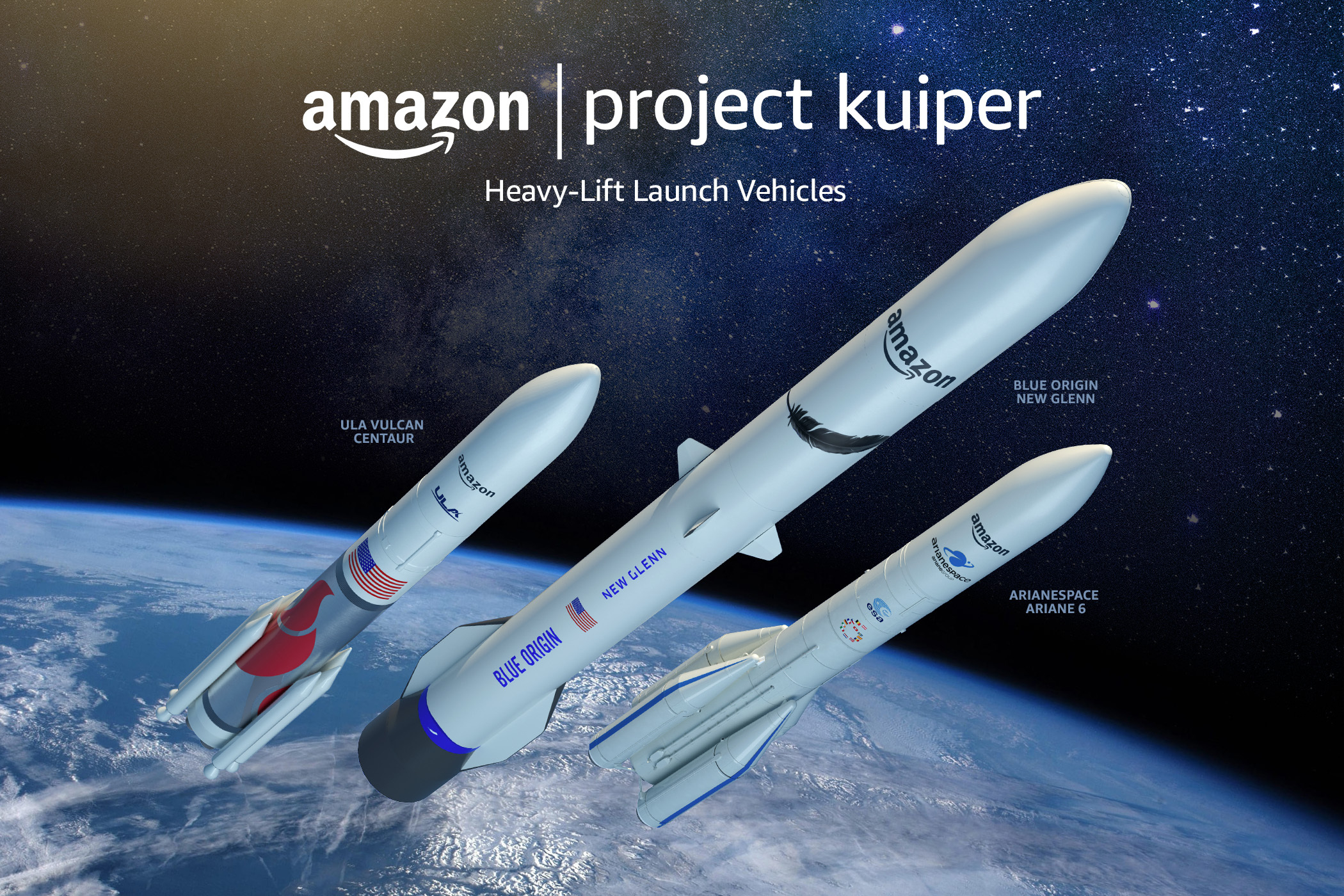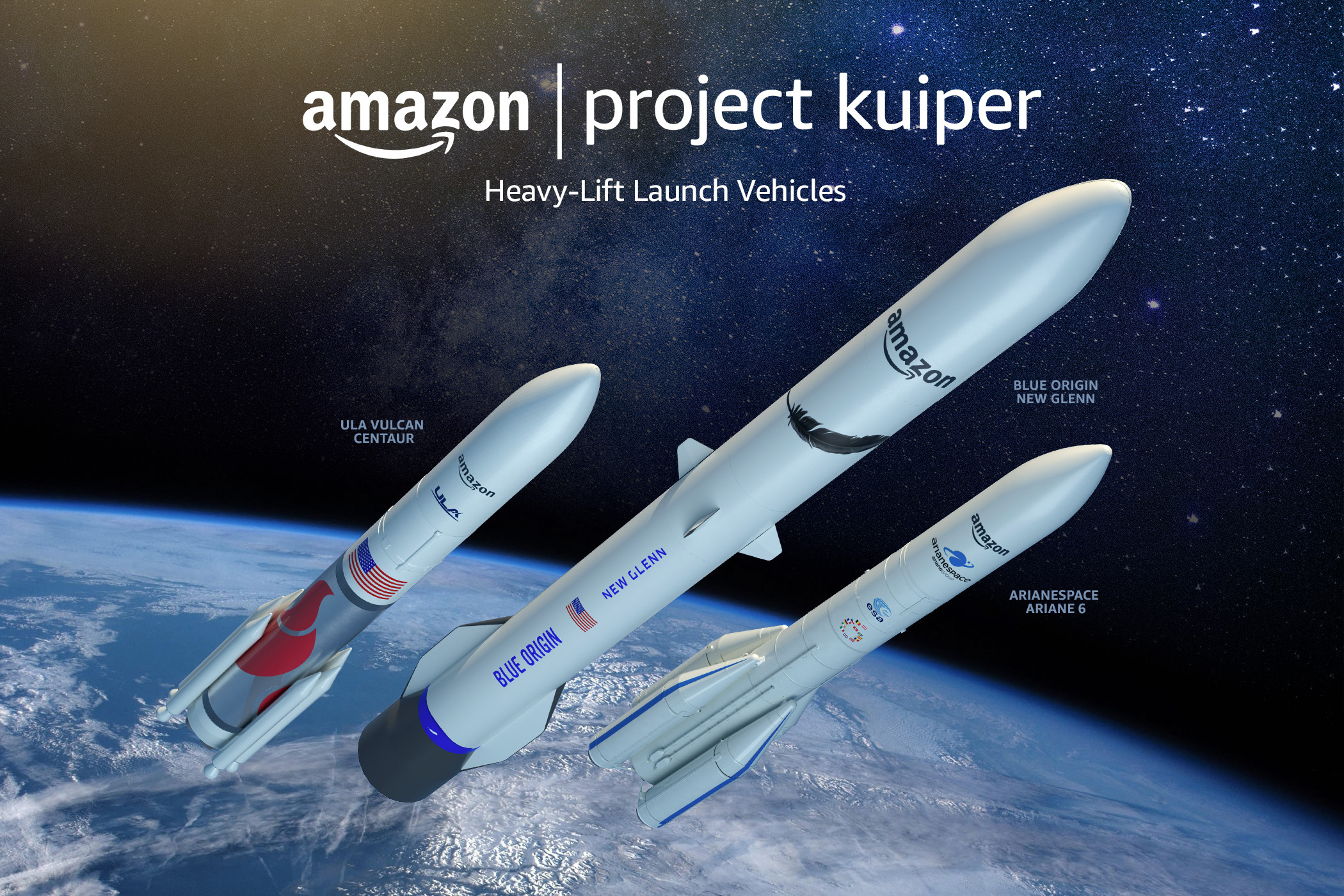
Amazon Just Bought A Ton Of Launches For Project Kuiper
While SpaceX and Starlink have made the most progress in recent years regarding low Earth orbit satellite constellations, they are not alone. For a while now, Amazon has been planning and working on its own named Project Kuiper. While the company has not yet launched any satellites, recent news suggests this will change significantly in the future.
As we know Amazon does not launch rockets. This means they need to purchase space within a launch vehicle in order to send satellites into space. Just a few days ago the company announced they had signed a record-breaking launch deal that covers up to 83 launches. This would be on ULA’s Vulcan Centaur, Blue Origin’s New Glenn, and Arianespace’s Ariane 6.
This constellation is planned to consist of around 3300 satellites in total. This is why so many launches are required to send a good portion of the satellites necessary into orbit. In addition, the estimated value of all these launches is around $10 billion. Here I will go more in-depth into the recent contract, Project Kuiper, the launch vehicles involved, and what to expect in the near future.
Recent News

Kuiper Systems LLC is a subsidiary of Amazon that was set up in 2019 to deploy a large satellite internet constellation to provide broadband internet connectivity. This is also known as Project Kuiper. Only a few days ago the company along with the multiple launch providers selected announced the contracts and launches that had been purchased. However, this was no ordinary contract but instead one of the largest in the industry with up to 83 launches planned. All of these launches are spread between ULA, Blue Origin, and Arianespace. Specifically, 38 launches on ULA’s Vulcan Centaur, 12 with an additional 15 with Blue Origin’s New Glenn, and 18 with Arianespace’s Ariane 6.
Only two days ago on April 5th, Blue Origin tweeted saying, “Amazon selects Blue Origin’s New Glenn for 12 launches, with options for up to 15 additional launches of Kuiper’s satellite constellation.” As I mentioned prior, Project Kuiper’s constellation of 3,236 advanced satellites aims to deliver high-speed, low-latency broadband service globally. The launches are manifested for a five-year period from Launch Complex 36 (LC-36) at Cape Canaveral Space Force Station, which Blue Origin has rebuilt from the ground up. “We’re honored to support Amazon’s ambitious mission to provide reliable, affordable broadband to unserved and underserved communities around the world through New Glenn and our BE-4 engines,” said Jarrett Jones, Senior Vice President, New Glenn, Blue Origin. “New Glenn’s massive seven-meter fairing offers unprecedented mass and volume capabilities, and provides Project Kuiper maximum launch flexibility. We also congratulate our partner, United Launch Alliance, who was also selected today by Amazon to support Project Kuiper. We’re proud to build American-made engines for ULA’s Vulcan Centaur.” New Glenn is a heavy-lift launch vehicle specifically suited to lift significant mass and volume to low Earth orbit. Its seven-meter fairing enables twice the payload volume of any five-meter class commercial launch system, and its reusable first stage is built for a minimum of 25 missions. New Glenn is powered by seven BE-4 engines and is capable of launching more than 13 metric tons to geostationary transfer orbit (GTO) and 45 metric tons to LEO. The BE-4 is intended to be the nation’s first reusable, oxidizer-rich staged combustion booster engine using liquid oxygen (LOX) and liquefied natural gas (LNG). In addition to Project Kuiper, New Glenn is also manifested to carry payloads for three of the six largest satellite operators in the world: Eutelsat, JSAT, and Telesat. NASA previously selected New Glenn for its launch services catalog, approving the rocket to compete for NASA’s advanced science and exploration missions. As many of us know New Glenn is not ready yet. Blue Origin is a lot less public regarding its progress compared to other companies and it can be hard to get a good idea of progress on large projects such as New Glenn. So far we have only seen a mockup of the launch vehicle and testing of the BE-4 engines. As of right now the company still has a lot of work prior to consistently launching satellites for Amazon or any other customer. New Glenn has been delayed multiple times based on the expected date for the first launch. Early last year Blue Origin suggested that we would see New Glenn take off late this year in 2022. We will have to wait and see how progresses over time.
However, Blue Origin is not the only company that was selected. Around the same time as Blue Origin, ULA, or United Launch Alliance tweeted saying, “ULA’s next generation #VulcanRocket chosen to launch majority of @Amazon’s Project Kuiper satellite constellation, supporting 38 launches.” After the news Tory Bruno, ULA’s president and CEO mentioned, “We strongly believe in the mission of Project Kuiper. We are honored to be entrusted with the majority of Amazon’s launches with a total of 47 missions, including the nine Atlas launches already on contract.” “At ULA we are focused on serving our customers and partnering with them to provide unmatched flight capabilities and mission operations and assurance, to provide the lowest risk and best-value launch solution.” The Vulcan missions will launch from Space Launch Complex 41 at Cape Canaveral Space Force Station in Florida. “ULA has decades of experience and a proven track record across dozens of successful commercial and government missions, and we’re proud to have them on our team,” said Rajeev Badyal, Vice President of Technology for Project Kuiper at Amazon. “Our work together to enhance launch operations at Cape Canaveral stands to benefit the broader space industry and contribute to greater resilience in space operations.” Not only this but“Vulcan Centaur’s unique, single-core, heavy lift design, coupled with its industry-leading large payload fairing, makes it an excellent fit for Amazon’s deployment of the majority of its Project Kuiper constellation,” said Chris Ellerhorst, ULA director of Strategy, Business Development and Sales. “In addition to the launches, this partnership includes substantial investments made by both companies in high-rate production, launch vehicle improvements, and launch infrastructure, to support Amazon’s long-term launch needs, which is great for the U.S. aerospace industry and supply chain.” Amazon’s goal for Project Kuiper is to make high-speed, low-latency broadband more affordable and accessible for unserved and underserved communities around the world. The initiative is designed to serve individual households, as well as schools, hospitals, businesses, government agencies, and other organizations operating in places without reliable broadband services. Looking at the number of launches ULA received, it’s likely they got the majority based on the progress of Vulcan and the company’s track record for mission success. Unlike some of the other companies picked, the Vulcan Centaur has made a lot of progress and is primarily just waiting on Blue Origin’s BE-4 engines before a test flight expected not long from now.
Finally, the last launch provider that was picked, Arianespace. At the same time as the other two companies, Arianespace tweeted saying, “We are proud to announce that we have signed a contract with @Amazon for 18 @Ariane6 launches to deploy #ProjectKuiper. The largest contract we have ever signed!” As you can imagine, these contracts are a very big deal for each of the companies involved. Whether they got just over 10 launches or over 30, it provides them with a guarantee for the near future of their launch vehicle and more. It also costs quite a bit for each launch provider. The Ariane 6 launch vehicle, a European Space Agency program, is meant to provide Arianespace with new levels of efficiency and flexibility to meet customers’ evolving launch services needs across a full range of commercial and institutional missions. Developed by ArianeGroup (Arianespace’s parent company) and its European industrial partners, Ariane 6 will deliver increased payload performance, plus enhanced flexibility to launch a wide range of missions with the same high reliability demonstrated throughout the Ariane program. The next-generation launch vehicle will be built in two versions: Ariane 62, which is perfectly suited for institutional missions; and Ariane 64, which primarily will serve the commercial market. Based on the companies picked, it looks as if Amazon is confident in the future launch vehicles and what these two companies and agency can produce. While none of the rockets have had their first test flight yet, some are getting close. The success will have a direct impact on Project Kuiper and much more.
Conclusion
While Starlink has made significant progress over the past few years, it is not the only low Earth orbit satellite constellation in the works. Amazon has been working on Project Kuiper for a while now and just made a very large purchase to send a majority of its satellites into LEO. Only a few days ago the company announced contracts with Blue Origin, ULA, and Arianespace for up to 83 launches. These launches are all planned on new launch vehicles including New Glenn, Vulcan Centaur, and Ariane 6. We will have to wait and see how it progresses and the impact it has on the space industry.
